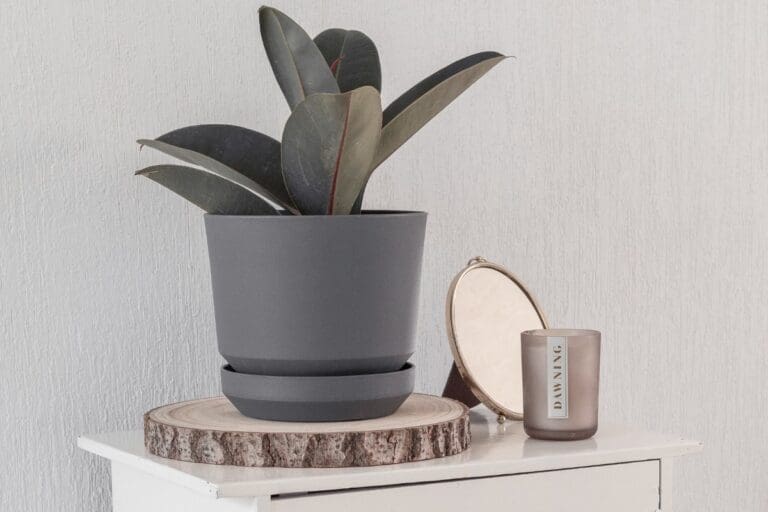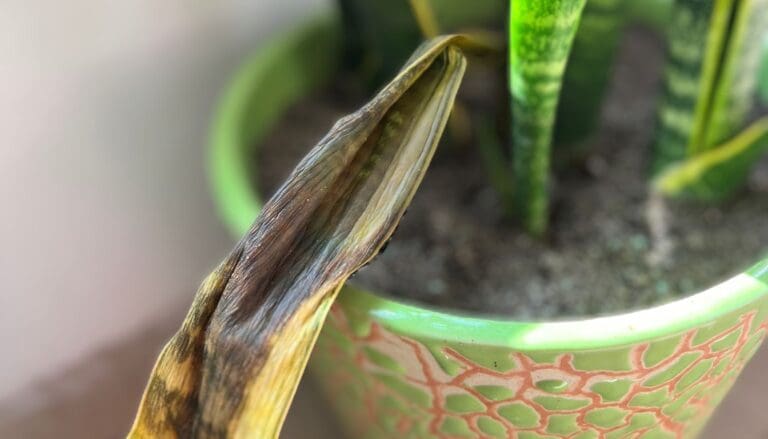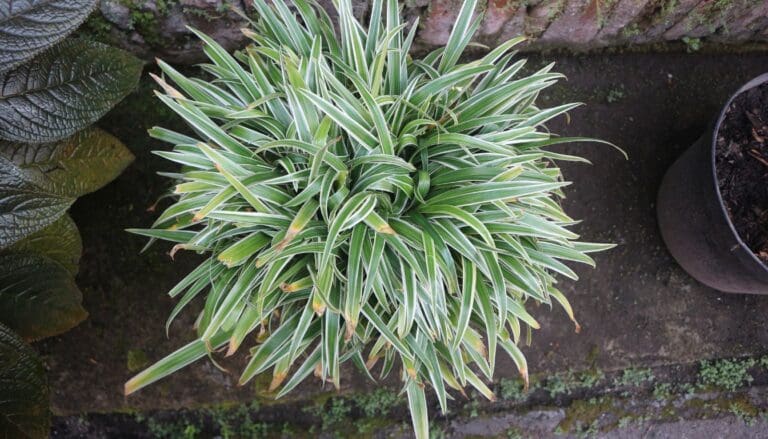How Do You Revive A Chinese Evergreen Plant? (Possible Problems+Fix)
Chinese Evergreen, also called Aglaonema, is a lovely plant with unique patterned leaves. Its primary weaknesses are cold injury and overwatering. But being hardy plants, it always bounces back in most circumstances.
So, if your Chinese evergreen is dying because of some problem then today we will teach you how to revive a Chinese evergreen plant.
To save a dying Chinese evergreen, you need to follow the following steps:
- Examine the plant and lookout for signs of possible problems.
- Inadequate watering is one of the most prevalent problems, so the first step is to look into the watering schedule.
- Check the soil moisture level and ensure that the pot and soil support adequate drainage.
- Fertilize the plant once or twice a year only.
- Move the plant to a spot where it gets bright indirect lighting. If the lighting is too low or too much, then adjust the same as needed.
- Look out for possible pest infestation and spray some neem oil and insecticidal soap to prevent the same.
Common reasons for a wilting Chinese Evergreen are overwatering, excess sunlight, pest infestations, cold injury, and copper deficiency. Whether a newbie or an expert, a dying plant is bound to bother you. However, you can still save it.
I have shared some easy ways to fix the issues and revive your dying Chinese Evergreen in this guide.

Please note: Simplify Plants is reader-supported. Some links in the post are affiliate links and I get a commission from purchases made through links in the post.
My Chinese Evergreen is dying: What should you know.
Chinese Evergreens are also called Aglaonema. They are a genus of flowering plants belonging to the arum family, Araceae. They originate from the tropical and subtropical regions of Asia and New Guinea.
They are hardy, low-maintenance, and durable plants that would even handle low light, drought, and dry air to some extent.
Although they can tolerate these, you should not stress these plants by letting them accept drought or dry air conditions for a long time. This will increase their risk of dying.
If you find that your Chinese evergreen is dying, a few reasons you should consider are improper watering, extreme exposure to sunlight, pest and fungus infestation, poor drainage, and extreme temperatures.
The hardy Chinese Evergreen will handle such poor situations for some time, but eventually, they will show signs of dying once these conditions persist for long.
What are the signs of a dying Chinese Evergreen plant?
When your plant is dying due to excess stress, it will show symptoms signifying that they are in inferior health. You need to know the signs and fix the issues at the initial stages to save your plant from dying.
The common symptoms include:
- Yellow or brown leaves
- Drooping leaves
- Curly leaves
- Dry and crispy foliage falling downwards
- Foul smell from the plant’s base and soil, indicating root rot
- Small and deformed leaves with kinked edges
What should you do when your Chinese Evergreen is dying?
For bringing the plant back to life, you must first comprehend the genuine reasons behind the dying Chinese Evergreen.
Identifying the exact cause will make it easier to treat the problem. Different problems involve different ways to revive a dying Chinese evergreen.
How to revive a Chinese Evergreen from overwatering and root rot?

Chinese Evergreens like to grow when watered moderately. They can survive drought to some extent but will not like overwatering conditions.
Underwatering can be solved quickly. But, overwatering will further lead to root rot.
When the roots stay in the water for a long time, they become soft and then trigger rotting. When this happens, the unhealthy roots fail to absorb water.
As a result, the plant wilts, leaves turn yellow and die at extreme damage levels. To save the plant from overwatering:
- Trim the discolored leaves.
- You need to stop watering immediately and shift the plant to a sunny location for some time. Don’t expose them to direct sunlight.
- A location receiving partial shade and good airflow will help the water dry out quickly.
- Add one layer of mulch to the soil surface. It can help in absorbing the excess moisture from the soil.
- For the next watering, check whether the top 1 to 2 inches of soil is dry or not. Only then can you start watering.
- When the roots get damaged, they will show signs of rot like extreme wilting or drooping. In severe conditions, the soil will release a foul odor.
Treating overwatering solves half the problems of root rot. However, when you see signs of overwatering, try checking the condition of the roots. If the roots have started rotting, you will need repotting.
Also read: How Do You Save An Overwatered Chinese Evergreen? (Signs, Causes & Fix)
For saving the plant from root rot:
- Take the Chinese evergreen out of the pot to check the roots. Don’t rush. If the plant is stubborn, tap the sides of the pot. Use a knife and poke the edges of the container to loosen the soil.
- Now remove the maximum amount of soil from the roots.
- Cut off the black and dark portions from the root portions. Use disinfected pruner or knife to cut them off.
- Apply a little mixture of fungicide and root hormone to the cut portions. Fungicide will prevent any fungus or bacterial infections due to cutting.
- Adding root hormone will help in root growth (If maximum roots need pruning).
- Take a pot, add clean river sand, damp it with fungicide solution and place the plant in it. After 30-36 days, you will find new root growth.
- Now, re-pot them with potting mix. Take a fresh pot and soil mix. Use 25% of each coconut coir/coco peat, river sand, soil, and compost. If you don’t have river sand or coco peat, you can use rice husks. These ingredients will ensure proper drainage.
- Along with it, add a little bit of fungicide to avoid any fungus infestation.
- Place the plant in the soil mix. Press all sides properly but not too hard. Keep them in indirect sunlight and water moderately.
- Don’t stress them further by overwatering or excess light.
- The use of fungicide at the cut portions and river sand will confirm that no fungus attacks the plants further. Fertilize after a few weeks.
Chinese Evergreen rarely suffers from fungal infections. Even if it does, overwatering and root rot are the major causes. Thus, never let your plant suffer from overwatering for long periods.
If you find initial signs of overwatering or root rot, like yellow leaves or lengthy wet soil, fix the problem quickly.
How to revive a dying Chinese Evergreen from cold injury?

You will find grey, greasy patches on the surface of the leaves. It will turn yellow later on. It indicates that your plant suffered from a cold injury. Other signs are droopy and limping leaves.
The reason behind cold injuries can be excess temperature drop for a long time, or it got exposed to air conditioners for extended periods.
To save the plant from dying due to cold injury:
- Remove the plant from the place where they are constantly receiving cold air.
- Remove the damaged leaves from the plant. They are not coming back green.
- Relocate your Chinese evergreen to a place where they won’t get any cold air from open doors or windows and air conditioners.
- Add a layer of mulch, like dark barks and leaves, on the surface soil to control the soil temperature. It will prevent the cold drafts from reaching the roots.
- Avoid overwatering. Reduce watering in winters.
- Ensure that the surrounding temperature of the plant ranges from 68-77°F all the time. However, some hardy varieties like Emerald Star or Jewel of India can endure 50-55°F without any signs of damage.
Also read: Chinese Evergreen Winter Care: Light, Watering, Fertilizing & More
How to fix the light issues for your Chinese evergreen?
Chinese Evergreens are those houseplants that will survive under low light conditions. But they will be unable to bear direct sunlight.
To understand whether your plant is getting too much light or not, check out for signs like yellow leaves, the plant growing straight upwards stiffly, and leaves having brown patches denoting sunburns.
When you see the plant dying having these signs, fix it immediately with the following steps:
- The drooping or stiff upward leaves will be back to normal. But the pale leaves having signs of sunburns will not turn green. So, snap off those damaged leaves.
- Relocate them to a shady place where direct sunlight cannot reach them. Bring them a few feet back from a sunny window. You can arrange translucent curtains or Venetian blinds for filtered sunlight.
- Keeping the soil evenly moist during the summers can reduce sunburn risks.
Also read:
- How Much Light Does A Chinese Evergreen Need? (Light Requirements)
- Can Chinese Evergreen Get Too Much Sun? (Chinese Evergreen Got Sunburn)
How to save Chinese Evergreen from a pest infestation?

Pest infestation is one of the most severe issues in all plants. In Chinese evergreen, the most common insect that can kill the plant are scales.
Your plant will appear weak and yellow despite giving them sufficient requirements.
Because scales feed on the leaves, you will also find holed, deformed leaves. When you check the plant closely, you will see disc-shaped brown colored insects loitering on the surface and beneath the leaves.
Other types of pests are aphids and spider mites that feed on the plant’s sap, making it lifeless. If not approached quickly, the plant will soon be on the brink of death.
A sticky substance called honeydew on the leaf surface is a sign of pest and spider mite infestation.
Observing the plants will find light green-colored pests on the leaf surface or beneath, indicating aphid infestation.
In the case of spider mites, web-like structures will be visible on the leaf tips and edges. The leaves will have small moving black spots, suggesting spider mites.
To revive the dying plant due to scale infestation:
- Separate the plant from other houseplants to prevent spreading.
- Remove the affected leaves from the plant.
- Give your Chinese evergreen a good shower to remove the pests.
- Damp a cloth in lukewarm soapy water and clean the leaves with it.
- Wear gloves while dealing with pests with hand.
- Clean all the leaves thoroughly from top to bottom.
- Concentrate more on the infested parts. You can also do it by damping cotton with rubbing alcohol.
- Spray some insecticide soap to remove the remaining pests. You can also try neem oil. It is natural and safe.
- Let the plant be in a shaded area to rest.
- Try not to overwater the plant.
- To prevent insect or bug infestation, use sticky card traps to trap insects and bugs.
- In some cases, only showering or removing them with a cloth won’t give good results. But spraying insecticide soap or neem oil will ensure all the bugs got removed.
- You can try using mild liquid dish wash soap and water solution. First, you should try on a small portion of the leaves. If it works, go ahead. Wipe the leaves after a few hours to dry them out and remove the dead bugs.
- One natural way to remove aphids is ladybugs. Ladybugs will eat up all the aphids without harming your precious Aglaonema.
The common reasons behind pest infestation are unhealthy plants due to poor light conditions, nutrient deficiency, and poor soil moisture. Try to avoid such situations to keep your plant healthy and long-lasting.
Also read: Do Chinese Evergreen Get Bugs? (Common Bugs+How To Get Rid Of Them)
How to revive Chinese evergreen from copper deficiency?

Generally, nutrient deficiency doesn’t kill the plant. But one deficiency that occurs when the plant gets attacked by cold injury is a copper deficiency.
The roots get affected by cold temperatures, like below 55-65°F for too long. Such low temperatures reduce the plant’s capacity to absorb copper.
Another reason is infertile soil and improper fertilizing.
You will see the leaves turning yellow, smaller in size, and distorted with kinked edges. If kept in such a condition for long, the plant will die.
To revive the plant from such dull circumstances:
- Try foliar spraying with a micro-nutrient spray containing copper as one of the nutrients. Go through the instructions carefully before using these.
- Don’t expose your plant to temperatures below 65°F. They grow best at temperatures from 68-77°F all year.
- Feed them with a balanced fertilizer once a month during the spring and summer.
- Stop fertilizing when the temperature starts dropping. They won’t take up any nutrients in winter due to dormancy.
- If your region is not that cold and your plant just reduced its growth, you can feed them a little every six weeks.
- If the soil is not working well, repot with fresh potting soil. It will give the plant fresh nutrients and save it from stress or death. Do it during the growing season every two years.
Also read: Does Chinese Evergreen Plant Needs Fertilizer? (How Often+Best Fertilizer)
Final thoughts

Now that we have discussed every possible way to revive a dying Chinese Evergreen, you must have known that there is always hope if you observe and catch the signs of damage early.
Though it is unfortunate to see the lovely-looking Chinese Evergreen dying, there is always the option of saving it at its initial stage. Taking action for an unhealthy plant at an early phase will help revive the plant quickly.
Both novice and experienced gardeners can make mistakes. So don’t get disheartened when you see your plant dying. By following the procedures I discussed rightly, you can save your Chinese Evergreen.
How do I save my dying plant? – FAQs
Below I shared some frequently asked questions and answers to ease the revival process for you.
Will the brown or yellow leaves turn back green?
No, the discolored leaves will not turn back green. It is better to discard them. It will save the plant’s energy to use it more for being back to health.
Why does my Chinese Evergreen turn yellow?
The common causes are overwatering, underwatering, or poor soil drainage. Water the plant adequately once a week only. For poor drainage, you can use compost to improve it.
Is it necessary to remove the damaged leaves?
Yes, it is essential if the damage is 50% or more. It will stop the reason of damage from further circulating. It also improves the look and allows the plant to focus more on the revival of the plant.
Reference: Wikipedia, Nasa clean air study, Missouri Botanical Garden, The University of Kansas, NC State University.
Recommended Garden Supplies
| Product Image | Our Recommended Gardening Supplies | Check Offers! |
|---|---|---|
Top Top
Top
Top
Top
Top
Top
Top
Top | rePotme Houseplant and Tropical Classic Potting Soil Mix | Check Offer On Amazon |
 Top
Top
Top
Top
Top
Top
Top
Top | Espoma Organic Indoor Plant Food | Check Offer On Amazon |
 Top
Top
Top
Top
Top
Top
Top
Top | GooingTop LED Grow Light 6000K Full Spectrum Clip Plant Growing Lamp | Check Offer On Amazon |
 Top
Top
Top
Top
Top
Top
Top
Top | Soil Moisture Meter | Check Offer On Amazon |
 Top
Top
Top
Top
Top
Top
Top
Top | Govee Hygrometer Thermometer, Bluetooth Enabled! | Check Offer On Amazon |
 Top
Top | LEVOIT Humidifiers for Large Room(Best For Plants) | Check Offer On Amazon |
 Top
Top
Top
Top
Top
Top
Top
Top | Upgraded DIY Automatic Drip Irrigation Kit, 15 Potted Houseplants Support | Check Offer On Amazon |
 Top
Top
Top
Top
Top
Top
Top
Top | Stainless Steel Heavy Duty Gardening Tool Set | Check Offer On Amazon |
 Top
Top
Top
Top
Top
Top
Top
Top | Bonide Insecticidal Soap | Check Offer On Amazon |
 Top
Top
Top
Top
Top
Top
Top
Top | Bonide 32 oz Spray Neem Oil for Organic Gardening | Check Offer On Amazon |
 Top
Top
Top
Top
Top
Top
Top
Top | Garden Safe Fungicide | Check Offer On Amazon |






